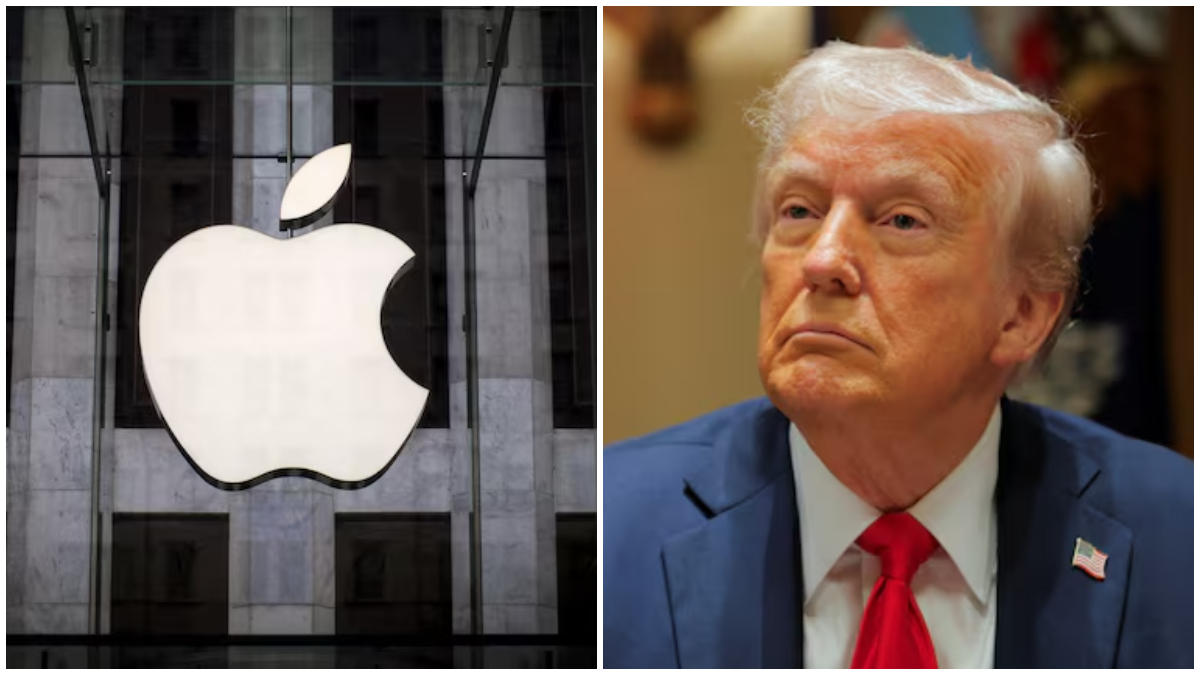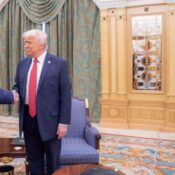
Trump rekindles trade concerns by threatening to impose fresh tariffs on Apple and the European Union
President Donald Trump of the United States threatened to intensify his trade war once more on Friday, threatening to impose a 25% tax on all imported iPhones purchased by American consumers and calling for a 50% tariff on goods from the European Union to go into effect on June 1.
After weeks of de-escalation had given the tariff dispute some respite, the dual threats, delivered via social media, rocked international markets. While the price of gold, a safe haven for investors, increased, major U.S. stock indexes and European shares plummeted, and the currency weakened. Fears about the impact of tariffs on economic development caused U.S. Treasury yields to decline.
The White House’s perception that talks with the bloc are not moving quickly enough led to Trump’s diatribe against the EU. His saber-rattling also signaled a return to Washington’s halt-and-go trade war, which has shook consumers, companies, and markets and sparked concerns about a worldwide economic collapse.
Additionally, the president’s attack on Apple is his most recent attempt to persuade a particular business to relocate its operations to the US, following in the footsteps of chipmakers, automakers, and pharmaceutical corporations. Even though Americans purchase over 60 million cellphones a year, the country does not mass-produce smartphones, and shifting production would probably result in a hundreds of dollar increase in the price of iPhones.
Trump then informed reporters inside the Oval Office that “Samsung and anybody that makes that product,” which is presumably a reference to cellphones, would also be subject to his proposed levy on Apple. By the end of June, he said, the new phone levy would be implemented.
Trump reaffirmed his criticism of the European Union for its poor treatment of the United States and its restrictions on American auto sales to the EU. “And I just said, ‘It’s time that we play the game the way I know how to play the game.'”
Trump responded, “I’m not looking for a deal,” when asked if he anticipated reaching an agreement before June 1. “We have a 50% deal in place. However, once more, if they locate their facility here, there is no tariff.
Following a phone conversation with U.S. counterpart Jamieson Greer and U.S. Commerce Secretary Howard Lutnick on Friday, EU trade chief Maros Sefcovic stated that the European Commission, the EU’s executive branch, was completely committed to reaching a mutually beneficial agreement. He went on to say that commerce between the US and the EU “must be guided by mutual respect, not threats.”
Dutch Prime Minister Dick Schoof told reporters in The Hague that the EU was likely to view this most recent announcement as part of the trade talks and supported the EU’s approach.
“We have seen before that tariffs can go up and down in talks with the U.S.,” he stated.
Following a frenzied sell-off of U.S. assets by investors, including government bonds and the U.S. currency, the White House halted the majority of the punitive tariffs that Trump had proposed in early April against almost every nation in the globe. Trump lowered his astronomical 145% tax on Chinese goods to 30% after maintaining a 10% baseline charge on the majority of imports.
Consumer prices for everything from Italian olive oil to German automobiles may increase if EU goods were subject to a 50% tax.
Last year, the EU exported over 500 billion euros ($566 billion) to the US, with Germany accounting for 161 billion, Ireland for 72 billion, and Italy for 65 billion. According to EU data, the top exports were pharmaceuticals, automobiles and auto parts, chemicals, and aircraft.
CONFLICT ABOUT TARIFFS
Although the White House has been negotiating trade with many nations, the pace of progress has been inconsistent. At a summit earlier this week in the Canadian Rocky Mountains, finance leaders from the Group of Seven industrialized countries attempted to minimize disagreements over the tariffs.
“The EU is one of Trump’s least favorite regions, and he does not seem to have good relations with its leaders, which increases the chance of a prolonged trade war between the two,” XTB research director Kathleen Brooks stated.
Negotiations with Japan seemed less tense.
Ryosei Akazawa, Japan’s senior trade negotiator, said the two sides discussed problems of economic security, non-tariff trade obstacles, and trade expansion after meeting separately with Lutnick and Greer on Friday. Their conversations were more intense and franker than before, he said.
Speaking to reporters, Akazawa stated that he would not rush to get a deal, even though it would be ideal if an agreement could be made before Trump and Japanese Prime Minister Shigeru Ishiba meet at the Group of Seven summit in Canada next month.
“Our country has national interests that must be protected, so it is not sufficient simply to forge an agreement quickly,” Akazawa stated. “As a negotiator, I can tell you that in negotiations the party stuck to a deadline usually loses.”
Although U.S. Treasury Secretary Scott Bessent declined to comment on additional possible trade agreements, he stated on Fox News that more would be revealed when the 90-day freeze on reciprocal tariffs draws to a close in July.
Regarding Trump’s threat to alter the exclusions he granted on smartphones and other gadgets imported primarily from China in a break for Big Tech companies that offer consumer goods, Apple chose not to respond. In an early Truth Social post, Trump claimed to have told Tim Cook, the CEO of Apple, “long ago” that “I expect their iPhones that will be sold in the United States of America will be manufactured and built in the United States, not India, or anyplace else.” This statement caused a 3% decline in Apple shares.
A person with knowledge of the matter said that Cook and Trump met on Tuesday.
Apple is accelerating plans to manufacture the majority of iPhones sold in the US at factories in India by the end of 2026 in order to avoid perhaps higher taxes in China. This is how Apple shares have responded to news of U.S. tariffs.
However, there are fewer chances of shifting production to the United States. Apple announced in February that it would invest $500 billion over four years in nine U.S. states, but the goal of the investment was not to bring iPhone manufacture to the country.
According to Gil Luria, an analyst at D.A. Davidson & Co., “it is hard to imagine that Apple can be fully compliant with this request from the president in the next 3-5 years,”
All Categories
Recent Posts
Tags
+13162306000
zoneyetu@yahoo.com



